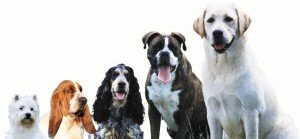What’s in a dog breed? Less than you might think

If you think those “perfect” pooches at dog shows are the shining examples of their breeds, think again.
A massive study of more than 80,000 individual dogs reveals there’s actually a lot of behavioral variation within any given breed, particularly when it comes to aggression.
“There is no other breed or species of animal with such a wide variety of appearance and behavior,” says Dr. James Serpell, an animal behaviorist at the University of Pennsylvania’s Center for Interaction of Animals & Society.
That variety in behavior is mostly man-made: Dog breeding practices developed to highlight certain behaviors or traits that humans found useful.
In the early days, that usually meant identifying dogs who were well-suited for herding, hunting and other work. But in the mid-19th century, there was a shift in breeding interests toward appearance and aesthetic. This was the beginning of a canine career change for many existing breeds.
“The fundamental purpose of dogs now is just to provide people with companionship,” Serpell says. “But then, a lot of these breeds still show those original behavioral predispositions to do particular things.”
That’s evident at the recently-held Westminster Kennel Club Dog Show, where we’re encouraged to judge dogs and their behavior using stereotypes based solely on dog breed. Beagles are pack dogs bred to hunt; terriers are hardwired to dig for small rodents; border collies are consummate sheep herders.
Serpell wants to know just how deeply ingrained those behaviors aret, but trying to gather data on domestic dogs led to a problem. “The behavior of dogs is difficult to study because they live in people’s houses where you can’t really observe them,” he says.
So he created C-BARQ, an online tool that lets dog owners dish on the behavior of their pets. Owners volunteer the information through a detailed survey that asks them how their dogs respond to different stimuli in their environment.
With more than 80,000 responses, C-BARQ may be the world’s largest collection of behavioral data on dogs. The information is yielding clear profiles and patterns, particularly regarding aggressive behavior.
Between 10 percent and 15 percent of dogs can show very high levels of aggression, Serpell says, while 20 or 30 percent show no aggression.
Pit bulls and Akitas, popular breeds for fighting and guard dog duty, show serious aggression toward other dogs. But the title for most aggressive overall actually goes to tiny dachshunds, which display heightened aggression toward dogs, strangers and even their owners.
Serpell says the C-BARQ data paints a more complex picture than expected, even within breeds. So judging a dog based solely on its breed overlooks one of the most important aspects of its behavior: The influence of its owner and environment.
“[Dogs] perceive signals from us that we’re not even aware we’re giving,” he says. “Little attributes of personality we may have, probably change the way they typically behave. It’s unendingly interesting to me.”
This story is based on a video from PRI’s Science Friday with Ira Flatow. Want to put your own dog’s records into C-BARQ? You can sign up at the project’s website.
- Behavior (12)
- Caring for your pet (266)
- cat (6)
- Community Events (19)
- dog (7)
- From Our Clients (15)
- Happy Tails (9)
- News (424)
- Press (53)
- Products (2)
- Questions (4)
- Recalls (1)
- Special Offers (5)
- Tips & Advice (231)
- Uncategorized (19)
- Veterinary Services (48)
